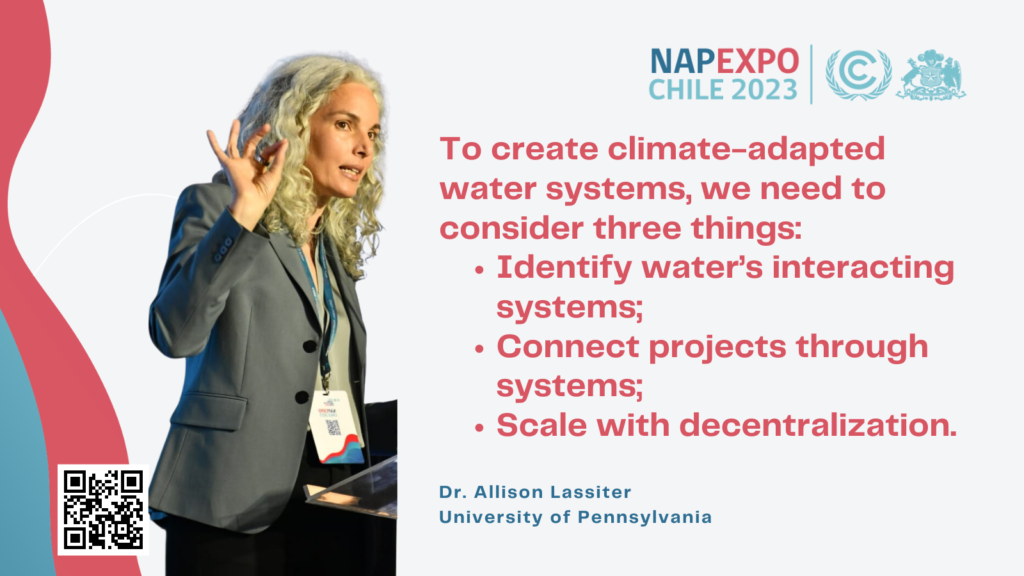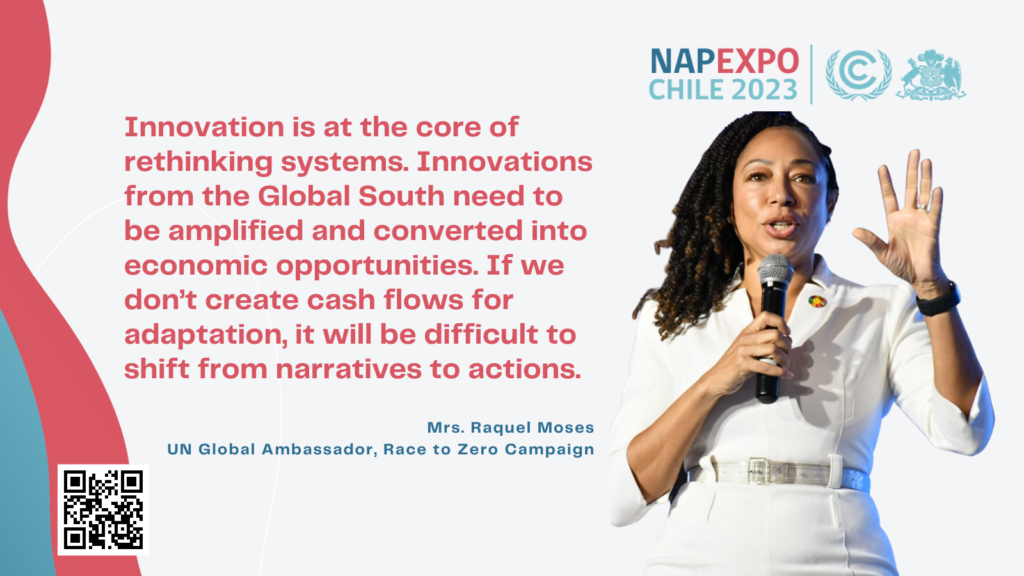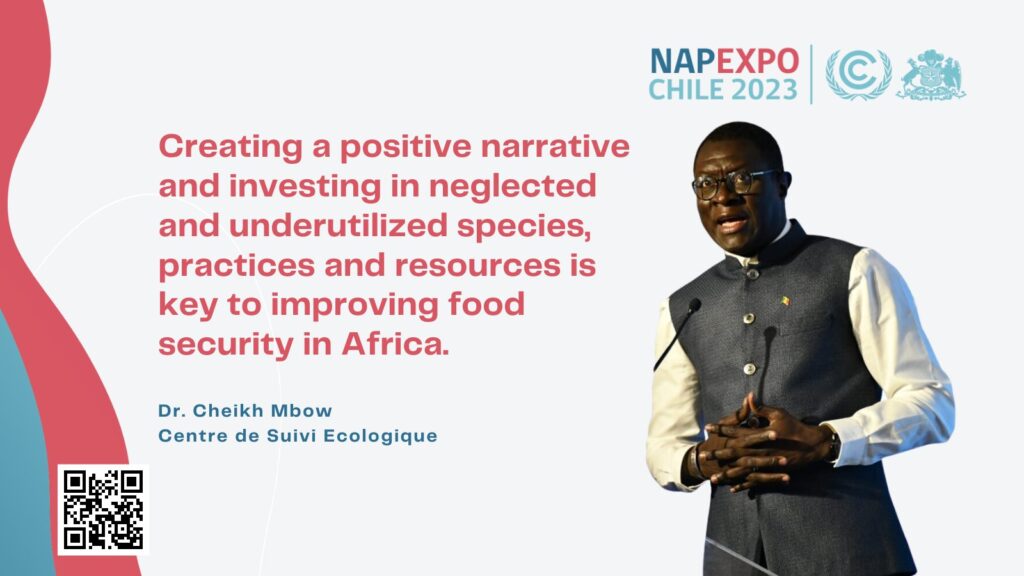

The second day of the NAP Expo saw participants diving deeper into issues regarding access to funding for adaptation, technical guidelines for the implementation of NAPs, transformations in food systems and water resources, as well as migration and displacement, and synergy between climate change adaptation and disaster risk reduction.
Scaling up adaptation through transformative and innovative practices
Resilience in food and water and the importance of innovation anchored the keynote speeches.
Dr. Allison Lassiter introduced the value of decentralized water systems to overcome the risks of variability in water supply and demand, and water quality decline, while also ensuring sustainable yield. She pointed out that most water systems are improperly sized and poorly maintained, but that there is an opportunity not to repeat the systems of the past, and instead build a 21st century system ready for population growth and climate change. Creating climate-adapted water systems, she said, requires three things: identifying water’s interactive systems, connecting projects through systems, and scaling with decentralization.

Mrs. Raquel Moses made a compelling case for “innovating our way out” of the problems we are facing and rethinking systems, in her talk on convening and creating economies of scale towards climate resilient development through project pipeline development. She described, among other things, the example of small island States working together and with foundations to secure food yields, the steps to bridging individual countries’ projects together to create economies of scale, the use of blue bonds, and amplifying and exporting innovations and converting them into economic opportunities. Creating funding flows for adaptation is needed to shift from narrative into action.

Dr. Cheikh Mbow detailed the importance of creating a positive narrative and investing in neglected and underutilized species, practices and resources in order to improve food security. Cantering on Africa, he cited the examples of favouring small sub value chains for crops in each country to accommodate a lack of connectivity between markets, investing in neglected and underutilized vitamin-rich species, cultivating alternative crops that take advantage of global trends and new markets, bringing back neglected agroforestry practices, tapping on forgotten water resources, and taking an integrated approach, which has had demonstrated benefits for land restoration in drylands.

Developing adaptation project pipelines and accessing climate finance
Funding for the formulation and implementation of NAPs is provided through the Green Climate Fund, the Least Developed Countries Fund, the Special Climate Change Fund as mandated by the Conference of the Parties to the UNFCCC. Access to available adaptation finance is of critical importance for all the developing countries, to drive adaptation action.
Despite the number of different challenges that the LDCs continue to face, many have made significant progress in advancing their adaptation efforts, building the resilience of their communities, and protecting their most vulnerable populations. The lessons from these will be valuable in informing the guidelines. In one session, three LDCs shared their experience with accessing funding for the implementation of their NAP. Sudan developed their NAP in 2016 and then used GCF readiness funding to develop a NAP implementation strategy which has led to several projects submitted for funding. Bhutan had the opposite experience, seeking implementation funding before completing their NAP, having already found success in identifying their priorities. South Sudan has yet to access funding for implementation but has been successful in securing bilateral funding.
Expanding technical guidelines and other guidance to facilitate implementation
Forty-four developing countries have now submitted a NAP, and the need for technical guidelines to facilitate the implementation of the priorities identified in these NAPs is becoming a priority. A session on technical guidelines for the implementation of NAPs, which are being developed by the Least Developed Countries Expert Group (LEG), with the support of a NAP technical working group subgroup and the Green Climate Fund, Global Environment Facility and Adaptation Fund, defined five steps to provide detailed guidance for the effective implementation of NAPs, taking into consideration inputs and feedback from experts and stakeholders, and through broad literature review. These are (i) ways to define the overall strategy for NAP implementation; (ii) institutional arrangements and legal frameworks for implementation; (iii) mobilizing resources for implementation (finance, technology, capacity-building); (iv) implementation of policies, projects and programmes; and (v) monitoring, evaluation and learning.
Zooming into implementation in a specific areas, a session on new guidance to develop and implement coastal adaptation integrating climate science showcased examples of climate science information for climate action and sought to advance the collaboration to craft supplemental guidance for the development and technical implementation of NAPs that have a focus on coastal areas.
Earth observations are critical to guide implementation, including strengthening the climate science basis for adaptation. Technical guidance is needed to support access to and use of data for implementing adaptation.
Transformative approaches in key systems
Water is both at the top of countries’ key climate risks, as well as priority areas for adaptation. Following on from the morning’s keynote presentations, at least two other sessions dealt with water, including the session on coastal adaptation, which addressed how observations could support assessments of risks and vulnerabilities, identify and assess options and inform the development and successful implementation of NAPs in the context of coastal challenges like erosion, saltwater intrusion and ocean acidification. Integrated water resources management (IWRM) in NAP formulation and implementation can help to ensure that water security is preserved in the face of climate change impacts. Incorporating water-related actions in water-dependent sectors such as agriculture and industry and making water a cross-cutting issue across all adaptation policies can help increase water security.
Migration and displacement, another burning transboundary issue, featured in today’s rich and varied discussions on key areas. One of the main points to emerge from the second UN4NAPs Forum session on migration and displacement in NAP formulation and implementation was that migration does not have to be negative— for example, it has long been an adaptation strategy for pastoralists— and planned relocation of communities can protect people at risk of or affected by climate change impacts. On the other hand, if not managed well, it can be a case of maladaptation, and can create conflicts between refugees and migrants and host communities over scarce resources. Human mobility and migration are multicausal and can take many forms, with both climate change impacts (slow onset events like sea level rise, changing rainfall patterns, droughts, or sudden onset events), conflict and economic crises among the contributing factors. The causes and impacts of migration need to be taken into account across adaptation sectors, including energy, access to drinking water, education, housing, waste management, land use and planning, urban/local authorities, statistics offices, as well as health and forestry. Integrating regional approaches and taking into account and systemize knowledge also on international, cross-border movements in the NAP process would help to have a more comprehensive picture. Data on migration, especially gender disaggregated data, is often lacking.
Then there are the risk-based approaches. Chile launched a Climate Risk Atlas (ARClim) project to assess and manage climate change risks through impact chains and risk maps, provide a platform for collaboration and information sharing among stakeholders, and promote a more coordinated and effective approach to climate change adaptation in Chile. The Atlas has been widely used by the public sector (i.e. in climate change sectoral and local adaptation plans) and by the private sector (i.e. inclusion of climate change in investment projects). Indicators for monitoring and evaluating progress in adapting to climate change in Chile were presented, reviewing implementation, progress, and outcome indicators. There are possibilities for the improvement of ARCLIM, such as the incorporation of adaptation indicators and of multi-risk analysis.

Enhancing synergy between climate change adaptation and disaster risk reduction examined the comprehensive approach to risk management that is needed to address the climate emergency requires effective mitigation, adaptation and disaster risk-reducing actions. Such an approach considers several factors to deliberately strengthen synergies between disaster risk reduction and climate change adaptation, identifying mutually beneficial opportunities across policies and programmes.